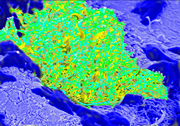- Number 311 |
- May 10, 2010
New carbon composite holds promise for bionics

Carbon nanotube channel
(yellow-green) in glass (blue).
Mimicking the human nervous system for bionic applications could become a reality with the help of a method developed at DOE's Oak Ridge National Laboratory to process carbon nanotubes.
While these nanostructures have electrical and other properties that make them attractive to use as artificial neural bundles in prosthetic devices, the challenge has been to make bundles with enough fibers to match that of a real neuron bundle. With current technology, the weight alone of wires required to match the density of receptors at even the fingertips would make it impossible to accommodate. Now, by adapting conventional glass fiber drawing technology to process carbon nanotubes into multichannel assemblies, researchers believe they are on a path that could lead to a breakthrough.
Full story:
http://www.ornl.gov/info/press_releases/get_press_release.cfm?ReleaseNumber=mr20100422-00.
[Ron Walli, 865.576.0226,
wallira@ornl.gov]
